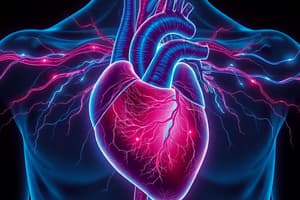Podcast
Questions and Answers
What is responsible for transporting oxygen, fluids, electrolytes, and metabolic products through the blood to and from tissues?
What is responsible for transporting oxygen, fluids, electrolytes, and metabolic products through the blood to and from tissues?
- Muscular system
- Cardiovascular system (correct)
- Heart, liver, and kidneys
- Brain, lungs, and intestines
Where is the heart located in the body?
Where is the heart located in the body?
- Between the lungs and beneath the sternum (correct)
- Outside the ribcage
- Behind the kidneys
- Above the stomach
Which vessels supply oxygenated blood to the heart muscles?
Which vessels supply oxygenated blood to the heart muscles?
- Aorta
- Hepatic portal vein
- Pulmonary arteries
- Coronary arteries (correct)
What is the function of the cardiac conduction system in the heart?
What is the function of the cardiac conduction system in the heart?
How is cardiac output calculated?
How is cardiac output calculated?
Which of the following is a non-traditional risk factor for cardiovascular disease?
Which of the following is a non-traditional risk factor for cardiovascular disease?
Flashcards are hidden until you start studying
Study Notes
- The cardiovascular system is responsible for transporting oxygen, fluids, electrolytes, and metabolic products through the blood to and from tissues.
- The heart, blood vessels, and blood together form the major transport system in the body, delivering oxygen and nutrients while removing waste.
- The heart is a hollow cone-shaped organ located between the lungs and beneath the sternum, with specific structures like atria, ventricles, and valves.
- Blood circulation through the heart involves deoxygenated blood entering through the vena cava, moving through the heart chambers, lungs for oxygenation, and then to the rest of the body.
- Coronary circulation supplies oxygenated blood to the heart muscles through coronary arteries and drains deoxygenated blood via cardiac veins.
- The cardiac cycle includes diastole (relaxation and blood refill) and systole (contraction and blood pumping).
- The cardiac conduction system involves nodes and fibers that stimulate heart contractions to pump blood effectively.
- Cardiac output is the amount of blood pumped by the ventricles in one minute, calculated by multiplying stroke volume and heart rate.
- Risk factors for cardiovascular disease include traditional factors like hypertension, elevated lipid levels, smoking, diabetes, obesity, and sedentary lifestyle.
- Non-traditional risk factors such as metabolic syndrome, elevated CRP levels, and high homocysteine levels can also impact cardiovascular health.
Studying That Suits You
Use AI to generate personalized quizzes and flashcards to suit your learning preferences.




